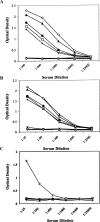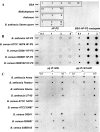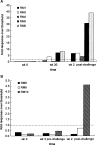Secondary cell wall polysaccharides of Bacillus anthracis are antigens that contain specific epitopes which cross-react with three pathogenic Bacillus cereus strains that caused severe disease, and other epitopes common to all the Bacillus cereus strains tested
- PMID: 19270075
- PMCID: PMC2682610
- DOI: 10.1093/glycob/cwp036
Secondary cell wall polysaccharides of Bacillus anthracis are antigens that contain specific epitopes which cross-react with three pathogenic Bacillus cereus strains that caused severe disease, and other epitopes common to all the Bacillus cereus strains tested
Abstract
The immunoreactivities of hydrogen fluoride (HF)-released cell wall polysaccharides (HF-PSs) from selected Bacillus anthracis and Bacillus cereus strains were compared using antisera against live and killed B. anthracis spores. These antisera bound to the HF-PSs from B. anthracis and from three clinical B. cereus isolates (G9241, 03BB87, and 03BB102) obtained from cases of severe or fatal human pneumonia but did not bind to the HF-PSs from the closely related B. cereus ATCC 10987 or from B. cereus type strain ATCC 14579. Antiserum against a keyhole limpet hemocyanin conjugate of the B. anthracis HF-PS (HF-PS-KLH) also bound to HF-PSs and cell walls from B. anthracis and the three clinical B. cereus isolates, and B. anthracis spores. These results indicate that the B. anthracis HF-PS is an antigen in both B. anthracis cell walls and spores, and that it shares cross-reactive, and possibly pathogenicity-related, epitopes with three clinical B. cereus isolates that caused severe disease. The anti-HF-PS-KLH antiserum cross-reacted with the bovine serum albumin (BSA)-conjugates of all B. anthracis and all B. cereus HF-PSs tested, including those from nonclinical B. cereus ATCC 10987 and ATCC 14579 strains. Finally, the serum of vaccinated (anthrax vaccine adsorbed (AVA)) Rhesus macaques that survived inhalation anthrax contained IgG antibodies that bound the B. anthracis HF-PS-KLH conjugate. These data indicate that HF-PSs from the cell walls of the bacilli tested here are (i) antigens that contain (ii) a potentially virulence-associated carbohydrate antigen motif, and (iii) another antigenic determinant that is common to B. cereus strains.
Figures






References
-
- Avashia SB, Riggins WS, Lindley C, Hoffmaster AR, Drumgoole R, Nekomoto T, Jackson PJ, Hill KK, Williams K, Lehman L, et al. Fatal pneumonia among metalworkers due to inhalation exposure to Bacillus cereus containing Bacillus anthracis toxin genes. Clin Infect Dis. 2007;44:414. - PubMed
-
- Baillie LW. Bacillus anthracis, a story of nature subverted by man. Lett Appl Microbiol. 2005;41:227–229. - PubMed
-
- Bystricky S, Machova E, Bartek P, Kolarova N, Kogan G. Conjugation of yeast mannans with protein employing cyanopyridinium agent (CDAP) – An effective route of antifungal vaccine preparation. Glycoconj J. 2000;17:677–680. - PubMed
-
- Choudhury B, Leoff C, Saile E, Wilkins P, Quinn CP, Kannenberg EL, Carlson RW. The structure of the major cell wall polysaccharide of Bacillus anthracis is species specific. J Biol Chem. 2006;281:27932–27941. - PubMed
Publication types
MeSH terms
Substances
Grants and funding
LinkOut - more resources
Full Text Sources
Molecular Biology Databases
Research Materials
Miscellaneous

